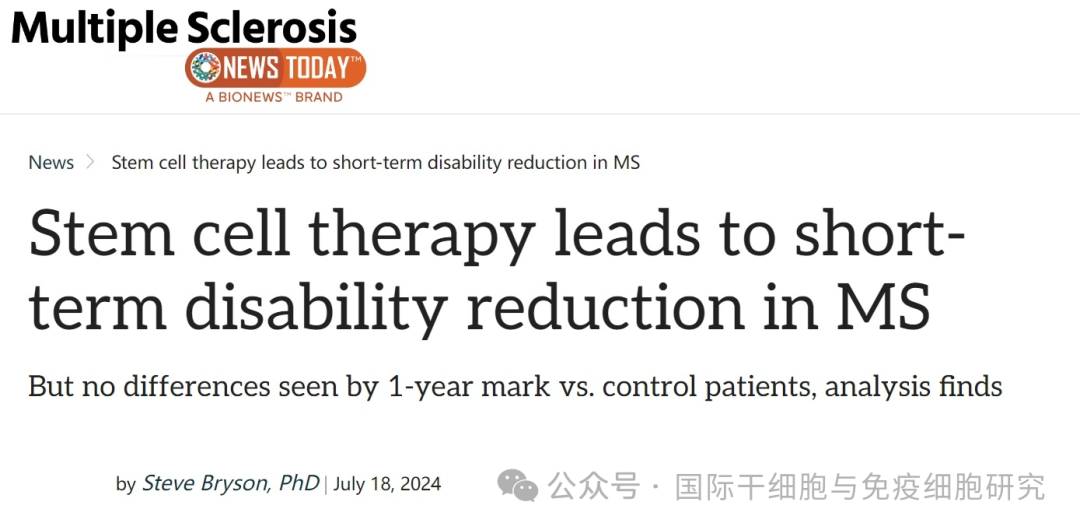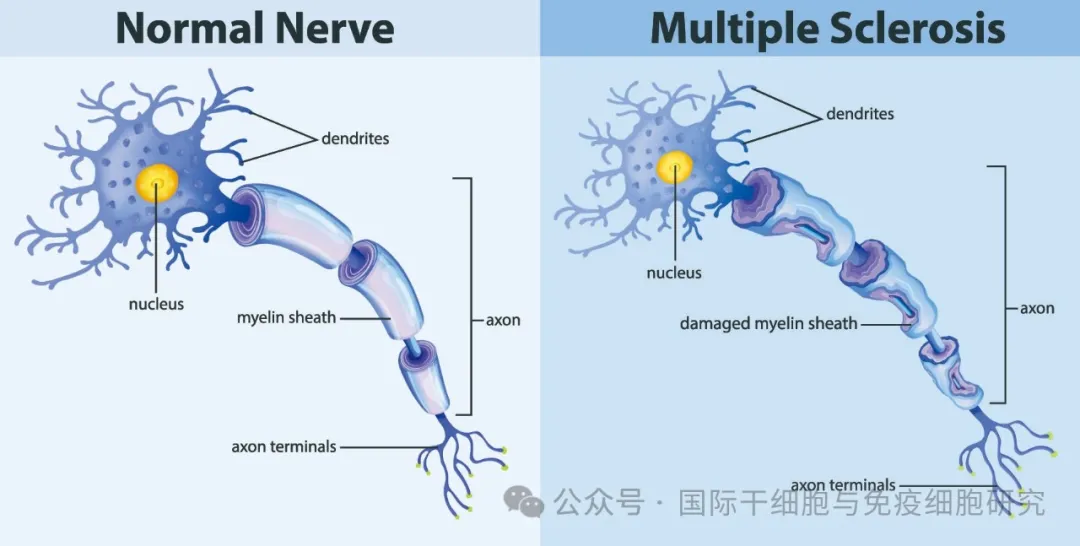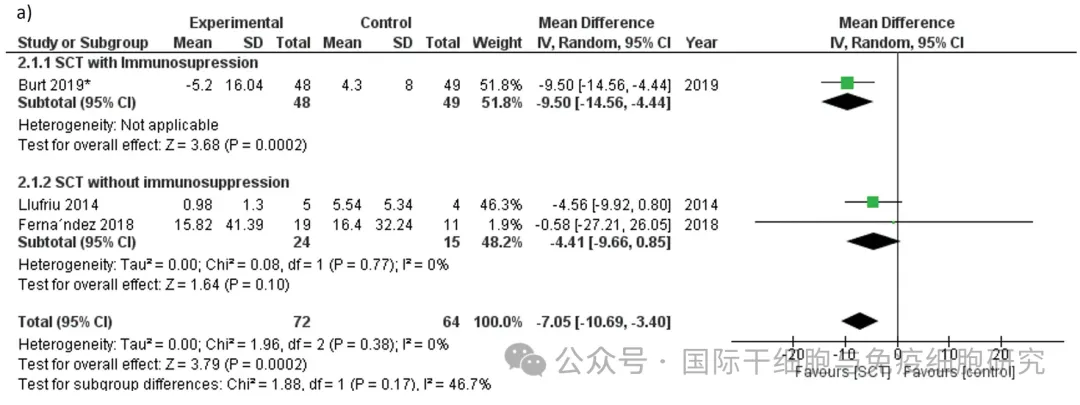
According to the external network, it was reported on July 22, 2024 that after receiving stem cell treatment for 2 months, patients with multiple sclerosis (MS) had improved their disability and showed a short-term reduction in the volume of brain lesions. The results were simultaneously published in the world. Published in the well-known journal Natural Science Reports.
So far, there is no cure for multiple sclerosis, patients have limited treatment options, and currently approved traditional therapies have limited clinical effects on progressive subtypes. Therefore, there is an urgent need to develop new therapies, and the emergence of stem cell therapy has undoubtedly brought a "new dawn" to patients with multiple sclerosis!

▲ The screenshot comes from "News Today"
What is multiple sclerosis?

Multiple sclerosis (MS) is a common autoimmune demyelinating neurological disease that affects patients 'movements, sensation and visual performance, affecting more than 2.8 million patients worldwide.
The disease is characterized by an autoimmune reaction that leads to demyelination of the brain and spinal cord and axon inflammation. It can cause permanent damage to the central nervous system, resulting in vision loss, dizziness, weakness, sensory disorders, and sphincter dysfunction. Some critically ill patients may even lose the ability to walk completely.
MS includes five main clinical courses: primary progressive multiple sclerosis (PPMS), secondary progressive multiple sclerosis (SPMS), relapsing and remitting multiple sclerosis (RRMS), clinically isolated syndrome (CIS), radiologically isolated syndrome (RIS).
Even after active treatment, two-thirds of patients will still develop secondary progressive multiple sclerosis (SPMS) within 25 to 30 years after diagnosis, and such patients are almost impossible to treat with existing methods.
Traditional treatments for multiple sclerosis and their limitations
Currently approved disease modification therapies (DMT) can be used to treat relapsing and remitting multiple sclerosis (MS) to help relieve symptoms or slow disease progression, but are only effective in the short term and have limited effectiveness in treating progressive subtypes. Commonly used drugs include:
1. Interferon beta (INF-β)
The risk of recurrence of recurrent MS can be reduced through immune regulation.
2. Teriflunomide, dimethyl fumarate
Helps reduce disease activity in recurrent MS.
3. Fingomode
It inhibits the migration of immune cells to the central nervous system and reduces disease activity. However, it may cause adverse reactions such as infection, liver damage, and bradycardia.
4. Mitoxantrone
It is the only drug approved by the U.S. FDA for the treatment of secondary progressive multiple sclerosis (SPMS). It can induce immunosuppression, but it has high cardiac toxicity and may pose a risk of hematological malignancies.
Why can stem cells treat multiple sclerosis?
Myelin helps speed up electrical signals, and the immune system of multiple sclerosis patients mistakenly attacks the protective layer of fat around nerve fibers-the myelin sheath. Once the myelin sheath is lost, it will lead to dysfunction in neuron communication and eventually cause a series of symptoms of multiple sclerosis.
Stem cell transplantation (SCT) is a potential way to reset the erroneous immune response and stop these misleading inflammatory attacks. Clinically, healthy stem cells can be infused back into patients through intravenous reinfusion, intrathecal injection (subarachnoid injection) and other methods, with the purpose of resetting their immune system. After transfusion, the stem cells migrate to the brain injury site, helping to regenerate damaged myelin sheath and inducing tissue repair. This regenerative process is attributed to the ability of stem cells to differentiate into neurons and myelinogenic cells. In addition, stem cells can also exhibit immunoregulatory functions by inhibiting autoimmune lymphocytes that attack white matter in the brain, thus having the potential to protect nerves.
Clinical studies have found that mesenchymal stem cells (MSC) can improve MS symptoms and delay disease progression; in addition, they also exhibit immunoregulatory and anti-inflammatory functions without the need for strong immunosuppression. After stem cells are infused back, it is expected to improve patients 'quality of life and promote clinical rehabilitation.
Natural Science Report: Two months after stem cell transplantation, disability and brain damage in patients with multiple sclerosis have improved
In order to assess the impact of stem cell transplantation (SCT) on MS, a meta-analysis in Natural Science Reports (Registration No.: CRD42022324141) compared 9 randomized controlled trials (RCTs), recruited a total of 422 patients with multiple sclerosis and divided them into stem cell transplantation (SCT) group and control group. The results showed that 2 months after stem cell transplantation (SCT), the patient's disability status improved and the volume of brain lesions also decreased.
1. Improvement of disability status: Patients 'disability status was evaluated using the Extended Disability Status Scale (EDSS). After 2 months of treatment, the reduction in EDSS in the stem cell transplant group was significantly greater than that in the control group, which was −1.08 (stem cell transplant group) vs −0.06 (control group), respectively. See the figure below.

▲ Picture source "scientific reports"
2. Reduced brain injury volume: SCT also reduced brain injury volume, and MRI T2 injury volume significantly reduced [MD=−7.05, 95% CI (−10.69, −3.4), p =0.0002]. See the figure below for details.
▼ MRIT2-weighted lesion volume at end of treatment

▲ Picture source "scientific reports"
In summary, stem cell transplantation (SCT) at 2 months can improve the disability status of patients with multiple sclerosis and reduce the volume of their brain lesions. The stem cell transplantation was well tolerated and no serious adverse reactions were observed during the follow-up period.
Messages
If multiple sclerosis is not treated in a timely and targeted manner, the immune system will continue to attack the myelin sheath, which may eventually cause irreversible damage or degradation of the nervous system. However, unfortunately, existing treatment methods usually focus on improving symptoms, and it is difficult to effectively prevent the disease from continuing to progress.
Therefore, there is an urgent need to explore new treatments. In recent years. With the development of regenerative therapies such as stem cells, it has brought a ray of light to patients with multiple sclerosis! It is expected to delay disease progression, improve patient outcomes, and improve quality of life by regulating immunity, protecting and repairing nerves, and inhibiting inflammation! The clinical study conducted in more than 400 patients in this "Natural Science Report" also verified the huge application potential of stem cells in the treatment of multiple sclerosis. Xiaobian also looks forward to seeing the longer-term efficacy of stem cells and benefiting more patients!
参考资料
[1]Nawar A A,et al.Efficacy and safety of stem cell transplantation for multiple sclerosis: a systematic review and meta-analysis of randomized controlled trials[J].Scientific Reports,2024, 14(1): 12545.
https://www.nature.com/articles/s41598-024-62726-4
[2]https://www.managedhealthcareexecutive.com/view/new-study-shows-short-term-benefits-of-stem-cell-therapy-for-ms-patients-but-long-term-efficacy-remains-unclear
[3]Genchi,A,et al.Neural stem cell transplantation in patients with progressive multiple sclerosis: an open-label, phase 1 study. Nat Med 29, 75–85 (2023).
https://www.nature.com/articles/s41591-022-02097-3
[4]https://multiplesclerosisnewstoday.com/news-posts/2024/07/18/stem-cell-therapy-leads-short-term-ms-disability-reduction-study/